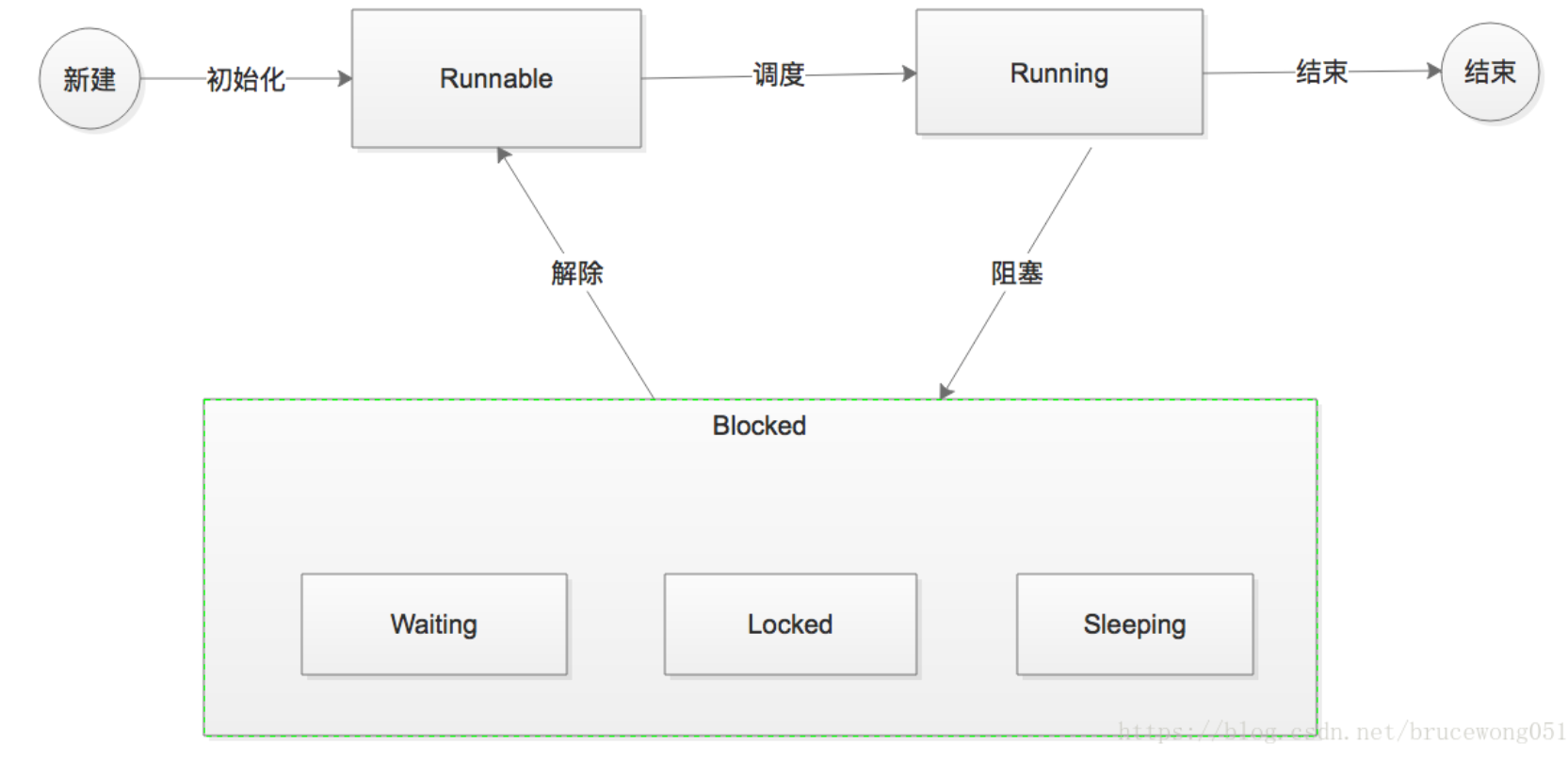Reference - basic concept, join, setDaemon
序言
这篇文章是对Reference系列文章的个人理解与总结
基本概念
- 线程的状态分为以下几种
- Runnable/Ready
- Running
- Blocked
- Waiting 线程主动调用 wait() 方法,等待来自其他线程的 notify() 唤醒
- Locked
- Sleeping 线程主动调用sleep() 或 join() 让自身block
来自 Reference - basic concept, join, setDaemon 的参考图

- 开线程:
import threading
import time
#定义线程需要做的内容,写在函数里面
def target():
print('当前的线程%s 在运行' % threading.current_thread().name)
time.sleep(1)
print('当前的线程 %s 结束' % threading.current_thread().name)
print('当前的线程 %s 在运行' % threading.current_thread().name)
t = threading.Thread(target=target,args = [])
t.start() #线程启动
print('当前的线程 %s 结束' % threading.current_thread().name)
其中最重要的是:
t = threading.Thread(): 声明线程
t.start() 启动线程
join()
- 假设我们有两个线程: 主线程和子线程。通常是子线程使用join(),使得主线程必须等待子线程完成后才可以继续。程序拓展为:
t = threading.Thread()声明线程
t.start()启动线程
t.join(Timeout)阻塞主线程。如设置Timeout,则只阻塞这么久
setDaemon(True)
- 设置在线程启动前。当没有join() 时,setDaemon(True) 可以保证主线程结束时程序不会退出,直到子线程结束。程序拓展为:
t = threading.Thread(): 声明线程
t.setDaemon(True)守护线程
t.start()启动线程
lock & Rlock
-
互斥锁,用于解决多线程访问共享变量的问题
-
声明锁。
lock = threading.Lock()
lock = threading.RLock() -
获得锁。使用时线程首先blocked,直到获得锁/Timeout时返回是否获得锁,如获得,则运行
lock.acquire(Timeout) -
释放锁。线程结束时将锁释出
lock.release() -
lock 与 Rlock的区别:
- 如果对lock连续使用release() 会出现死锁问题
- Rlock要求acquire() 与 release() 成对出现,较为常用
Condition
-
是一个条件变量。
通过设置的条件来控制线程的激活。
Condition的对象维护了一个锁 + 一个wait池 -
声明Condition对象
con = threading.Condition() -
wait()方法 调用wait() 时,线程blocked并进入wait池
-
notify()方法 调用notify() 时,Condition对象选择wait池中的一个线程,让其调用acquire() 尝试获取锁
-
典型的例子
- 生产者消费者问题 Reference - Condition
- 强化学习action与observation的交互
- 在每一步 step() 中: Agent首先publish一个action到Simulator,调用wait() 暂时block自己
- Agent的Subscriber收到来自Simulator的message,在Callback中获取observation,调用notify() 重新激活 step() 线程
- step() 完成全部操作,返回observation得到的观测数据
Event
-
通过一个 Flag 控制线程的状态
-
声明Event对象
event = threading.Event() -
wait(timeout)
t = threading.Thread(): 声明线程
event.wait(Timeout)block自己,等待被唤醒 -
set(); isSet(); clear()
event.set()将Flag改为True,唤醒所有在等待的线程event.isSet()检查标志状态event.clear()将Flag重置为False
Timer
- 声明timer对象
timer = threading.Timer(interval, function, args=[ ], kwargs={ })- interval: 指定的时间,在interval时间后开始thread
- funtion: 要执行的函数
- args/kwargs: 函数的参数
- start() & cancel()
timer = threading.Timer(interval, function, args=[ ], kwargs={ })
timer.start()
timer.cancel(): 在start后,thread真正激活前,可以取消start
Local
- 声明local对象
localManager = threading.local()
这个对象可以被当作一个全局变量,自身有一些属性。
每个thread对这个全局变量的读写都是隔离的。
(需要在具体项目中才能理解)